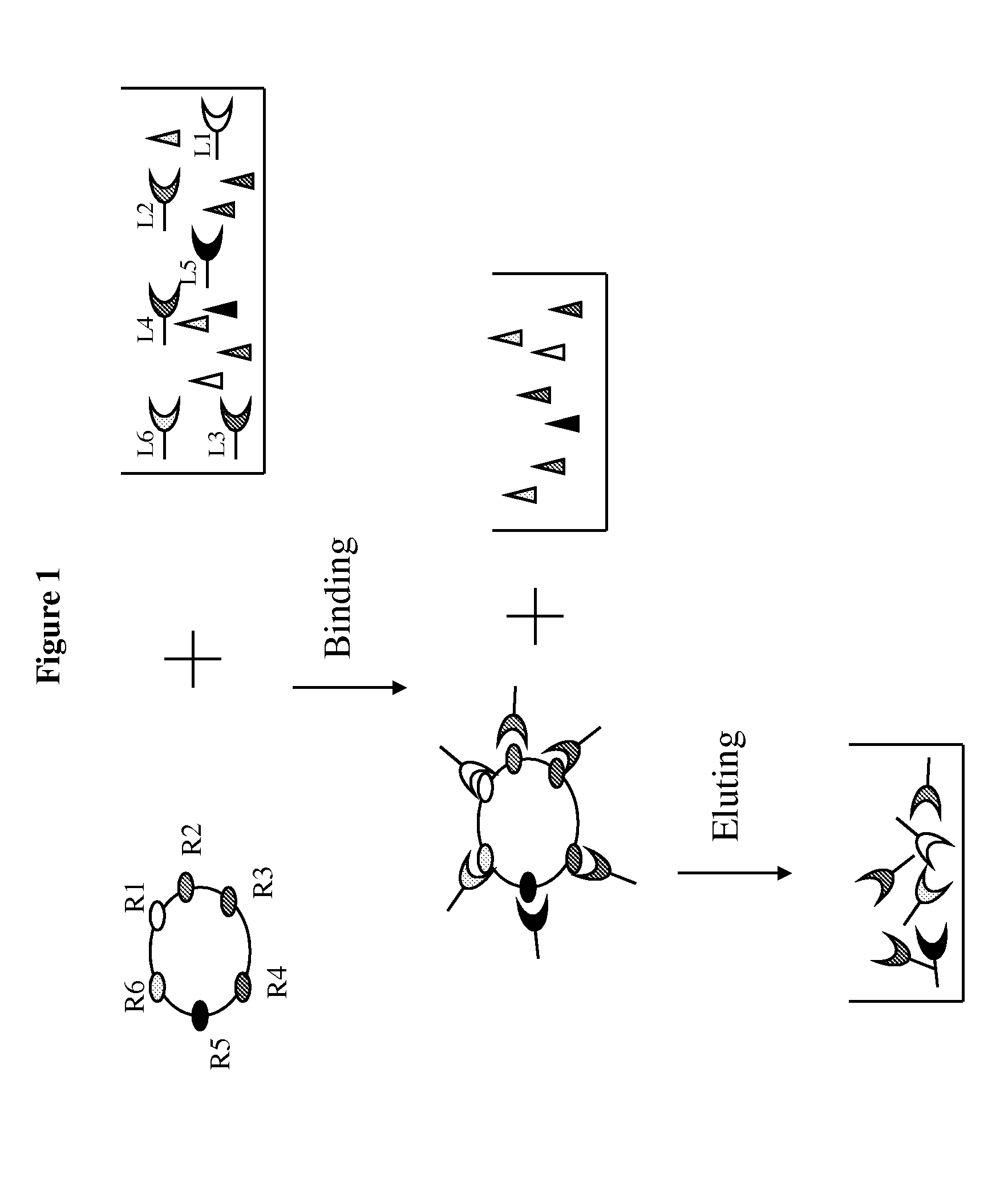Method of selective protein enrichment and associated applications
a protein enrichment and protein technology, applied in the field of proteomics, can solve the problems of only detecting around 3000 proteins from a given sample, proteomic methods are generally lacking proteome-wide analysis tools, and the difficulty of proteomic research is far more difficult than genomic research
- Summary
- Abstract
- Description
- Claims
- Application Information
AI Technical Summary
Problems solved by technology
Method used
Image
Examples
example 1
Ligand and Enrichment of a Human Serum Sample Using Hela Cells and NIH3T3 Cells as Receptor Carriers
[0098]A confluent monolayer of Hela or NIH3T3 cells in a 10-cm culture plate was first washed with 10 mL DMEM medium without serum and then replenished with 10 mL DMEM medium without serum, followed by incubation in a tissue culture incubator for 1 hour. After the incubation, DMEM medium was removed and the Hela cells were washed again with ice cold PBS, followed by incubation with 2.5 mg / mL IgG or 2-10 mg / mL BSA in ice cold PBS or PBS only at 4° C. for 30 min on a shaker to derive “prepared” Hela or NIH3T3 for ligand enrichment. After the liquid was removed, the prepared cells were incubated with 2 mL of human serum diluted 1:20 or 1:50 in PBS for 30 minutes at 4° C. on a shaker to allow ligand-receptor association. The liquid was then removed from the cells bound with the ligands by aspiration. The ligand-bound cells were washed with PBS 1-3 times to remove any residual unbound prot...
example 2
EGF Enrichment Using Hela Cells as Receptor Carriers
[0099]One hundred μL of human serum with spiked recombinant EGF were diluted into 2 mL (1:20 dilution) with ice cold PBS and added into prepared Hela cells using IgG as blocking agent for ligand enrichment according to the description in Example 1. Two mL ice cold PBS without serum and recombinant EGF was used in parallel as the control. The solution of 500 mM NaCl and 50 mM Glycine pH3.0 was used for ligand elution.
[0100]The following samples were obtained during the enrichment process: 1) eluted ligands from the Hela cells incubated with serum and spiked EGF (EnriSerumEGF); 2) eluted solution from Hela cells incubated with PBS (Control); 3) 1:20 dilution of the serum with spiked EGF solution before incubating with Hela cells (SerumEGF) and after 30 min incubation with Hela cells (PostSerumEGF). A 1:10 dilution of serum was used for quantifying concentration of EGF present in the naive serum. One hundred μL of solution from each o...
example 3
Efficiency of PDGFaa Enrichment is Associated with Abundance of PDGF Receptor Alpha on the Cell Surface
[0102]To compare PDGFaa enrichment efficiency between NIH3T3 cells with high expression level of PDGF receptor alpha and Hela cells with low expression level of PDGF receptor alpha, 100 mL of human serum plus 400 pg spiked recombinant PDGFaa were diluted into 2 mL (1:20 dilution) with ice cold PBS and added into prepared Hela and NIH3T3 cells without blocking step for ligand enrichment according to the description in Example 1. Two mL ice cold PBS without serum and recombinant PDGFaa was used in parallel as control. A solution of 150 mM NaCl and 50 mM Glycine pH 3.0 was used for ligand elution. After ligand elution, cell lysates were prepared from Hela cells and NIH3T3 cells to confirm differences in PDGF receptor alpha expression levels.
[0103]The following samples were obtained: 1) eluted ligands from the Hela cells incubated with serum and spiked PDGFaa (EnriSHela); 2) eluted lig...
PUM
| Property | Measurement | Unit |
|---|---|---|
| incubation time | aaaaa | aaaaa |
| temperature | aaaaa | aaaaa |
| temperature | aaaaa | aaaaa |
Abstract
Description
Claims
Application Information
 Login to View More
Login to View More - R&D
- Intellectual Property
- Life Sciences
- Materials
- Tech Scout
- Unparalleled Data Quality
- Higher Quality Content
- 60% Fewer Hallucinations
Browse by: Latest US Patents, China's latest patents, Technical Efficacy Thesaurus, Application Domain, Technology Topic, Popular Technical Reports.
© 2025 PatSnap. All rights reserved.Legal|Privacy policy|Modern Slavery Act Transparency Statement|Sitemap|About US| Contact US: help@patsnap.com



